International Trade Finance and Investment: An Analysis Report
VerifiedAdded on 2020/10/22
|17
|4900
|488
Report
AI Summary
This report provides a comprehensive analysis of international trade finance and investment. It begins by outlining the background of financial markets and identifying key players, including individuals, investors, firms, brokers, and regulatory bodies. The report then defines and categorizes main financial instruments into equities, debts, and derivatives. A significant portion of the report focuses on capital allocation within both domestic and international markets, exploring the role of financial institutions and the impact of globalization. The report also includes an evaluation of an unspecified emerging economy, critically assessing the challenges posed by industrialization and trade policies. The analysis highlights the importance of effective capital allocation for economic growth, the roles of various financial entities, and the challenges faced in emerging economies due to trade policies and market dynamics. The report concludes with a summary of key findings and implications, emphasizing the interconnectedness of global finance and the need for strategic policy frameworks.
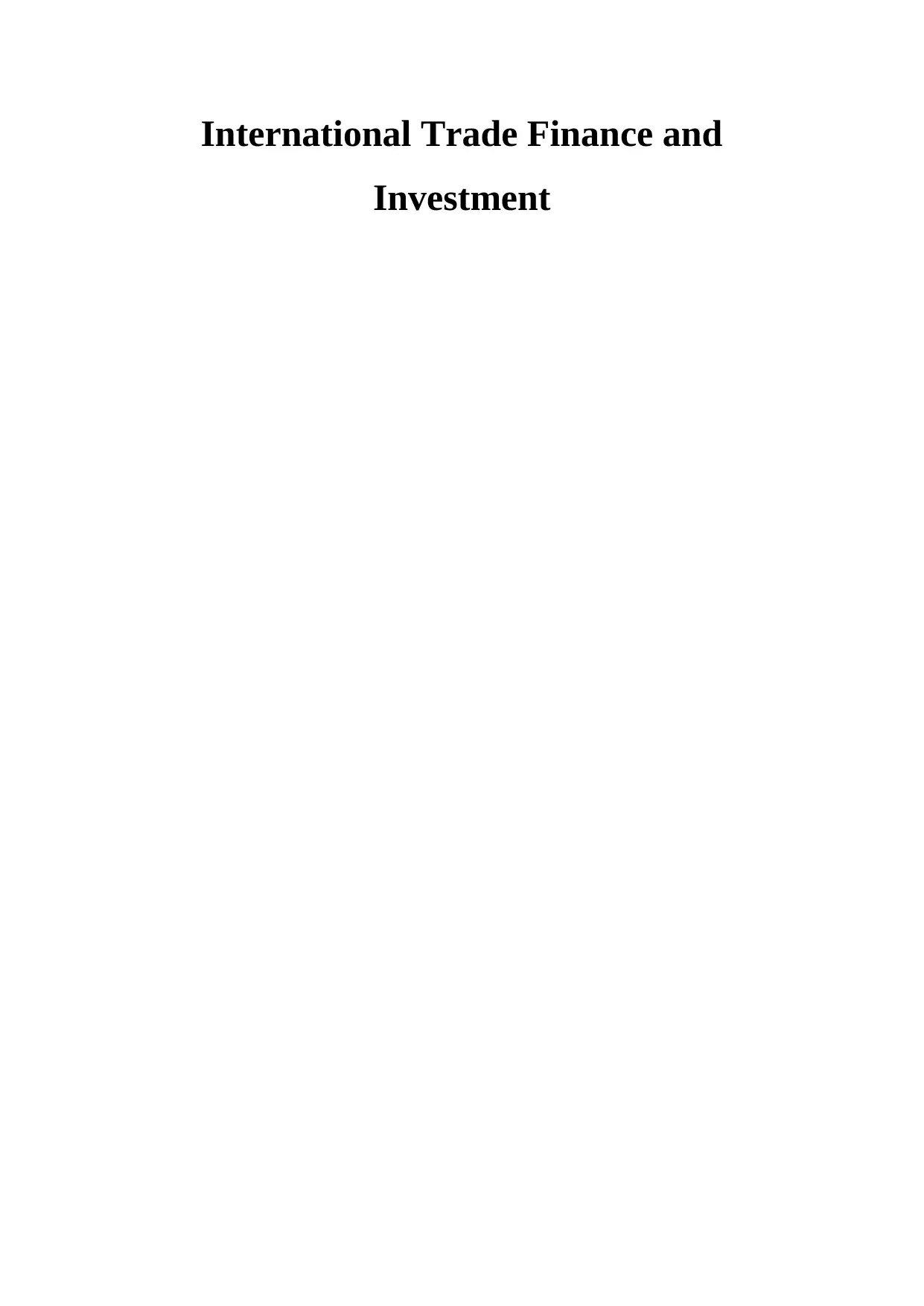
International Trade Finance and
Investment
Investment
Paraphrase This Document
Need a fresh take? Get an instant paraphrase of this document with our AI Paraphraser
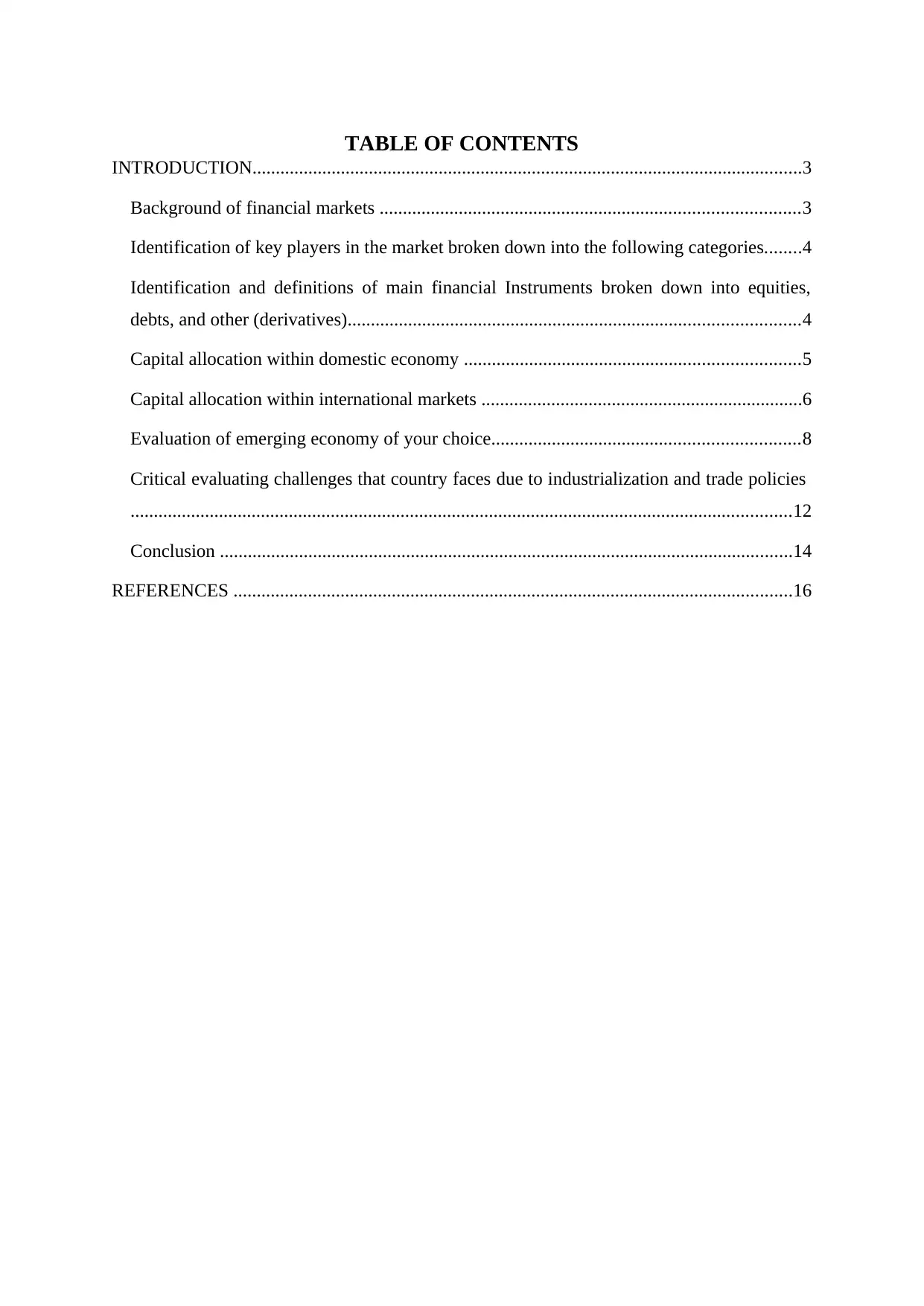
TABLE OF CONTENTS
INTRODUCTION......................................................................................................................3
Background of financial markets ..........................................................................................3
Identification of key players in the market broken down into the following categories........4
Identification and definitions of main financial Instruments broken down into equities,
debts, and other (derivatives).................................................................................................4
Capital allocation within domestic economy ........................................................................5
Capital allocation within international markets .....................................................................6
Evaluation of emerging economy of your choice..................................................................8
Critical evaluating challenges that country faces due to industrialization and trade policies
..............................................................................................................................................12
Conclusion ...........................................................................................................................14
REFERENCES ........................................................................................................................16
INTRODUCTION......................................................................................................................3
Background of financial markets ..........................................................................................3
Identification of key players in the market broken down into the following categories........4
Identification and definitions of main financial Instruments broken down into equities,
debts, and other (derivatives).................................................................................................4
Capital allocation within domestic economy ........................................................................5
Capital allocation within international markets .....................................................................6
Evaluation of emerging economy of your choice..................................................................8
Critical evaluating challenges that country faces due to industrialization and trade policies
..............................................................................................................................................12
Conclusion ...........................................................................................................................14
REFERENCES ........................................................................................................................16
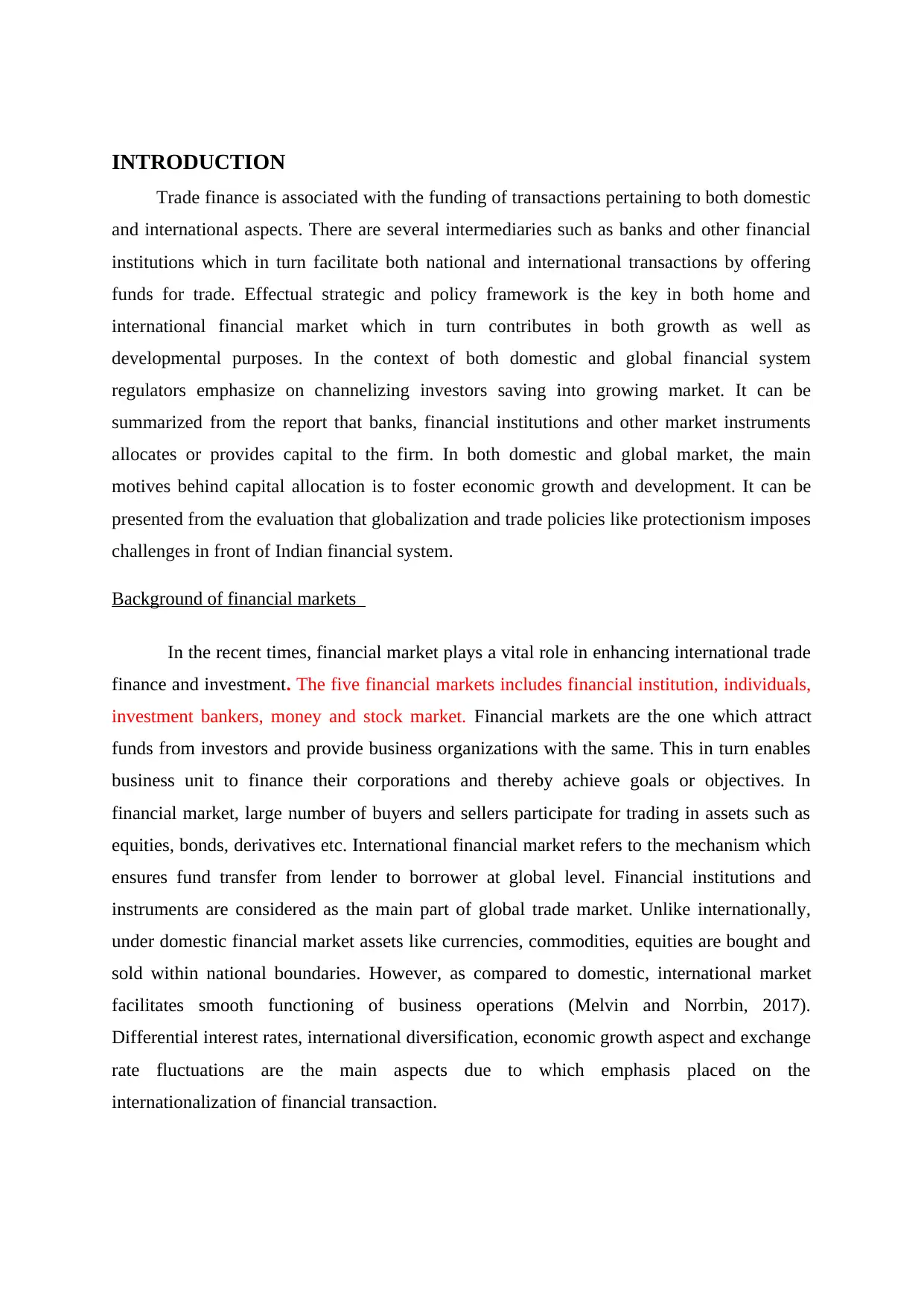
INTRODUCTION
Trade finance is associated with the funding of transactions pertaining to both domestic
and international aspects. There are several intermediaries such as banks and other financial
institutions which in turn facilitate both national and international transactions by offering
funds for trade. Effectual strategic and policy framework is the key in both home and
international financial market which in turn contributes in both growth as well as
developmental purposes. In the context of both domestic and global financial system
regulators emphasize on channelizing investors saving into growing market. It can be
summarized from the report that banks, financial institutions and other market instruments
allocates or provides capital to the firm. In both domestic and global market, the main
motives behind capital allocation is to foster economic growth and development. It can be
presented from the evaluation that globalization and trade policies like protectionism imposes
challenges in front of Indian financial system.
Background of financial markets
In the recent times, financial market plays a vital role in enhancing international trade
finance and investment. The five financial markets includes financial institution, individuals,
investment bankers, money and stock market. Financial markets are the one which attract
funds from investors and provide business organizations with the same. This in turn enables
business unit to finance their corporations and thereby achieve goals or objectives. In
financial market, large number of buyers and sellers participate for trading in assets such as
equities, bonds, derivatives etc. International financial market refers to the mechanism which
ensures fund transfer from lender to borrower at global level. Financial institutions and
instruments are considered as the main part of global trade market. Unlike internationally,
under domestic financial market assets like currencies, commodities, equities are bought and
sold within national boundaries. However, as compared to domestic, international market
facilitates smooth functioning of business operations (Melvin and Norrbin, 2017).
Differential interest rates, international diversification, economic growth aspect and exchange
rate fluctuations are the main aspects due to which emphasis placed on the
internationalization of financial transaction.
Trade finance is associated with the funding of transactions pertaining to both domestic
and international aspects. There are several intermediaries such as banks and other financial
institutions which in turn facilitate both national and international transactions by offering
funds for trade. Effectual strategic and policy framework is the key in both home and
international financial market which in turn contributes in both growth as well as
developmental purposes. In the context of both domestic and global financial system
regulators emphasize on channelizing investors saving into growing market. It can be
summarized from the report that banks, financial institutions and other market instruments
allocates or provides capital to the firm. In both domestic and global market, the main
motives behind capital allocation is to foster economic growth and development. It can be
presented from the evaluation that globalization and trade policies like protectionism imposes
challenges in front of Indian financial system.
Background of financial markets
In the recent times, financial market plays a vital role in enhancing international trade
finance and investment. The five financial markets includes financial institution, individuals,
investment bankers, money and stock market. Financial markets are the one which attract
funds from investors and provide business organizations with the same. This in turn enables
business unit to finance their corporations and thereby achieve goals or objectives. In
financial market, large number of buyers and sellers participate for trading in assets such as
equities, bonds, derivatives etc. International financial market refers to the mechanism which
ensures fund transfer from lender to borrower at global level. Financial institutions and
instruments are considered as the main part of global trade market. Unlike internationally,
under domestic financial market assets like currencies, commodities, equities are bought and
sold within national boundaries. However, as compared to domestic, international market
facilitates smooth functioning of business operations (Melvin and Norrbin, 2017).
Differential interest rates, international diversification, economic growth aspect and exchange
rate fluctuations are the main aspects due to which emphasis placed on the
internationalization of financial transaction.
⊘ This is a preview!⊘
Do you want full access?
Subscribe today to unlock all pages.

Trusted by 1+ million students worldwide
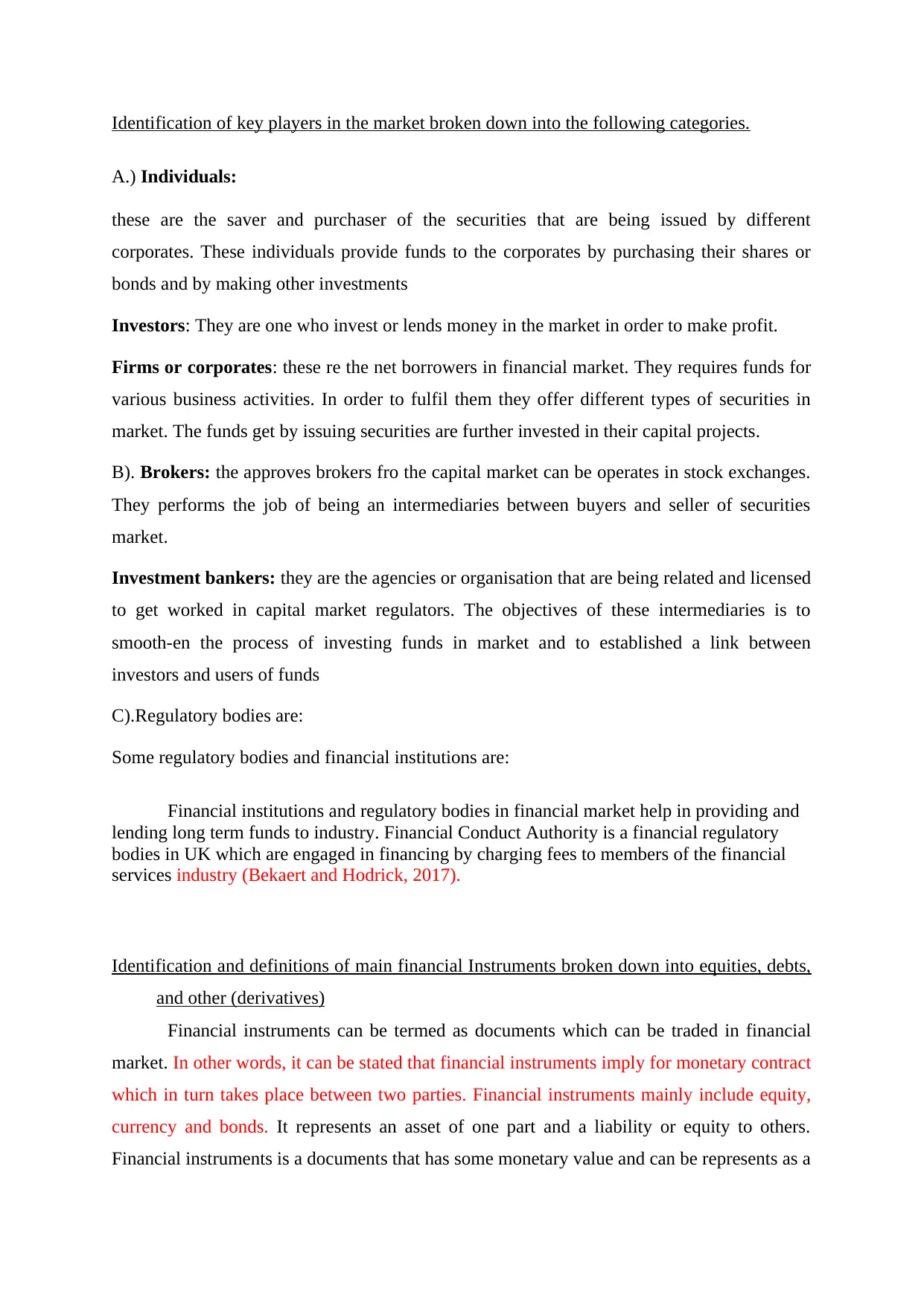
Identification of key players in the market broken down into the following categories.
A.) Individuals:
these are the saver and purchaser of the securities that are being issued by different
corporates. These individuals provide funds to the corporates by purchasing their shares or
bonds and by making other investments
Investors: They are one who invest or lends money in the market in order to make profit.
Firms or corporates: these re the net borrowers in financial market. They requires funds for
various business activities. In order to fulfil them they offer different types of securities in
market. The funds get by issuing securities are further invested in their capital projects.
B). Brokers: the approves brokers fro the capital market can be operates in stock exchanges.
They performs the job of being an intermediaries between buyers and seller of securities
market.
Investment bankers: they are the agencies or organisation that are being related and licensed
to get worked in capital market regulators. The objectives of these intermediaries is to
smooth-en the process of investing funds in market and to established a link between
investors and users of funds
C).Regulatory bodies are:
Some regulatory bodies and financial institutions are:
Financial institutions and regulatory bodies in financial market help in providing and
lending long term funds to industry. Financial Conduct Authority is a financial regulatory
bodies in UK which are engaged in financing by charging fees to members of the financial
services industry (Bekaert and Hodrick, 2017).
Identification and definitions of main financial Instruments broken down into equities, debts,
and other (derivatives)
Financial instruments can be termed as documents which can be traded in financial
market. In other words, it can be stated that financial instruments imply for monetary contract
which in turn takes place between two parties. Financial instruments mainly include equity,
currency and bonds. It represents an asset of one part and a liability or equity to others.
Financial instruments is a documents that has some monetary value and can be represents as a
A.) Individuals:
these are the saver and purchaser of the securities that are being issued by different
corporates. These individuals provide funds to the corporates by purchasing their shares or
bonds and by making other investments
Investors: They are one who invest or lends money in the market in order to make profit.
Firms or corporates: these re the net borrowers in financial market. They requires funds for
various business activities. In order to fulfil them they offer different types of securities in
market. The funds get by issuing securities are further invested in their capital projects.
B). Brokers: the approves brokers fro the capital market can be operates in stock exchanges.
They performs the job of being an intermediaries between buyers and seller of securities
market.
Investment bankers: they are the agencies or organisation that are being related and licensed
to get worked in capital market regulators. The objectives of these intermediaries is to
smooth-en the process of investing funds in market and to established a link between
investors and users of funds
C).Regulatory bodies are:
Some regulatory bodies and financial institutions are:
Financial institutions and regulatory bodies in financial market help in providing and
lending long term funds to industry. Financial Conduct Authority is a financial regulatory
bodies in UK which are engaged in financing by charging fees to members of the financial
services industry (Bekaert and Hodrick, 2017).
Identification and definitions of main financial Instruments broken down into equities, debts,
and other (derivatives)
Financial instruments can be termed as documents which can be traded in financial
market. In other words, it can be stated that financial instruments imply for monetary contract
which in turn takes place between two parties. Financial instruments mainly include equity,
currency and bonds. It represents an asset of one part and a liability or equity to others.
Financial instruments is a documents that has some monetary value and can be represents as a
Paraphrase This Document
Need a fresh take? Get an instant paraphrase of this document with our AI Paraphraser
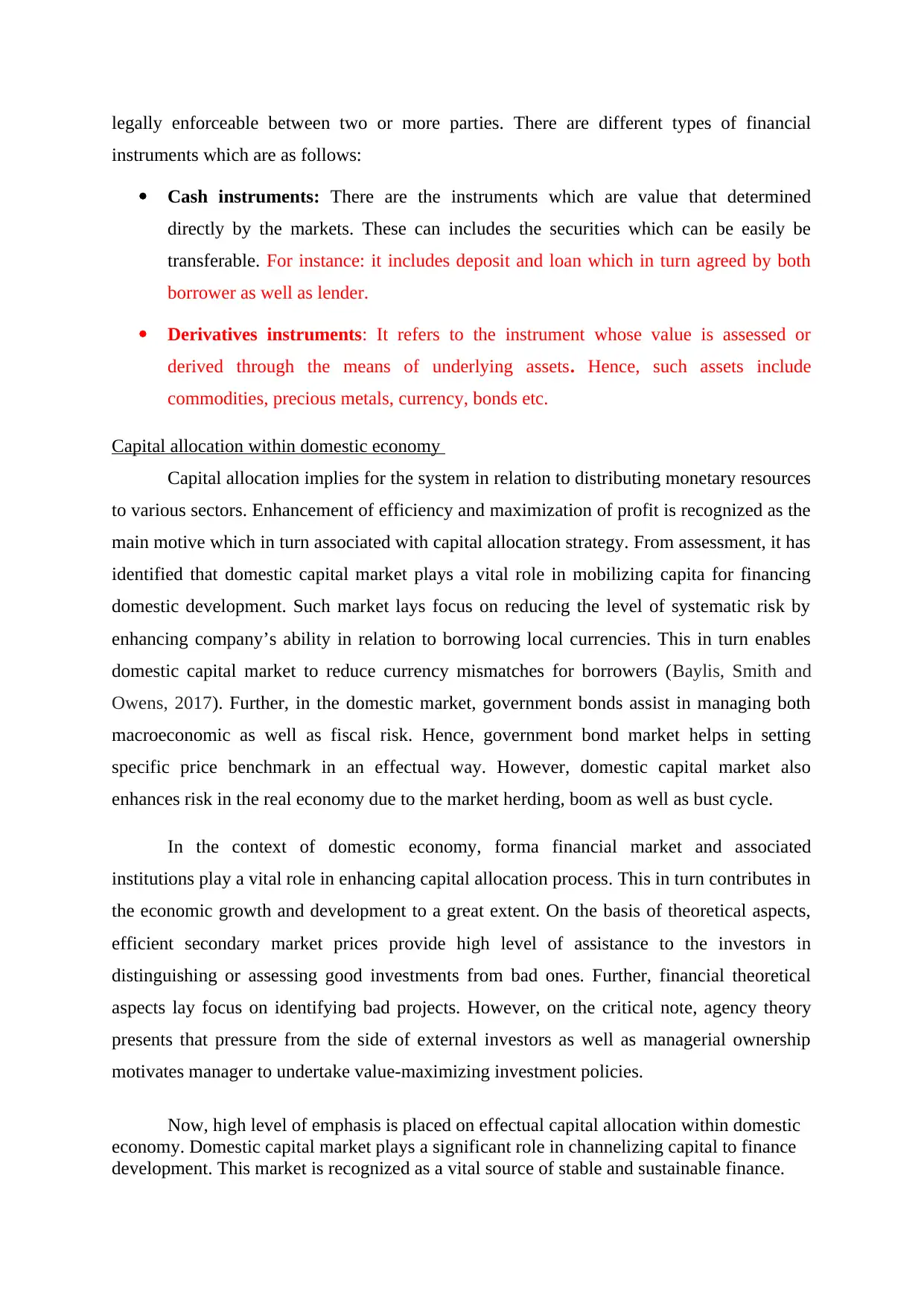
legally enforceable between two or more parties. There are different types of financial
instruments which are as follows:
Cash instruments: There are the instruments which are value that determined
directly by the markets. These can includes the securities which can be easily be
transferable. For instance: it includes deposit and loan which in turn agreed by both
borrower as well as lender.
Derivatives instruments: It refers to the instrument whose value is assessed or
derived through the means of underlying assets. Hence, such assets include
commodities, precious metals, currency, bonds etc.
Capital allocation within domestic economy
Capital allocation implies for the system in relation to distributing monetary resources
to various sectors. Enhancement of efficiency and maximization of profit is recognized as the
main motive which in turn associated with capital allocation strategy. From assessment, it has
identified that domestic capital market plays a vital role in mobilizing capita for financing
domestic development. Such market lays focus on reducing the level of systematic risk by
enhancing company’s ability in relation to borrowing local currencies. This in turn enables
domestic capital market to reduce currency mismatches for borrowers (Baylis, Smith and
Owens, 2017). Further, in the domestic market, government bonds assist in managing both
macroeconomic as well as fiscal risk. Hence, government bond market helps in setting
specific price benchmark in an effectual way. However, domestic capital market also
enhances risk in the real economy due to the market herding, boom as well as bust cycle.
In the context of domestic economy, forma financial market and associated
institutions play a vital role in enhancing capital allocation process. This in turn contributes in
the economic growth and development to a great extent. On the basis of theoretical aspects,
efficient secondary market prices provide high level of assistance to the investors in
distinguishing or assessing good investments from bad ones. Further, financial theoretical
aspects lay focus on identifying bad projects. However, on the critical note, agency theory
presents that pressure from the side of external investors as well as managerial ownership
motivates manager to undertake value-maximizing investment policies.
Now, high level of emphasis is placed on effectual capital allocation within domestic
economy. Domestic capital market plays a significant role in channelizing capital to finance
development. This market is recognized as a vital source of stable and sustainable finance.
instruments which are as follows:
Cash instruments: There are the instruments which are value that determined
directly by the markets. These can includes the securities which can be easily be
transferable. For instance: it includes deposit and loan which in turn agreed by both
borrower as well as lender.
Derivatives instruments: It refers to the instrument whose value is assessed or
derived through the means of underlying assets. Hence, such assets include
commodities, precious metals, currency, bonds etc.
Capital allocation within domestic economy
Capital allocation implies for the system in relation to distributing monetary resources
to various sectors. Enhancement of efficiency and maximization of profit is recognized as the
main motive which in turn associated with capital allocation strategy. From assessment, it has
identified that domestic capital market plays a vital role in mobilizing capita for financing
domestic development. Such market lays focus on reducing the level of systematic risk by
enhancing company’s ability in relation to borrowing local currencies. This in turn enables
domestic capital market to reduce currency mismatches for borrowers (Baylis, Smith and
Owens, 2017). Further, in the domestic market, government bonds assist in managing both
macroeconomic as well as fiscal risk. Hence, government bond market helps in setting
specific price benchmark in an effectual way. However, domestic capital market also
enhances risk in the real economy due to the market herding, boom as well as bust cycle.
In the context of domestic economy, forma financial market and associated
institutions play a vital role in enhancing capital allocation process. This in turn contributes in
the economic growth and development to a great extent. On the basis of theoretical aspects,
efficient secondary market prices provide high level of assistance to the investors in
distinguishing or assessing good investments from bad ones. Further, financial theoretical
aspects lay focus on identifying bad projects. However, on the critical note, agency theory
presents that pressure from the side of external investors as well as managerial ownership
motivates manager to undertake value-maximizing investment policies.
Now, high level of emphasis is placed on effectual capital allocation within domestic
economy. Domestic capital market plays a significant role in channelizing capital to finance
development. This market is recognized as a vital source of stable and sustainable finance.
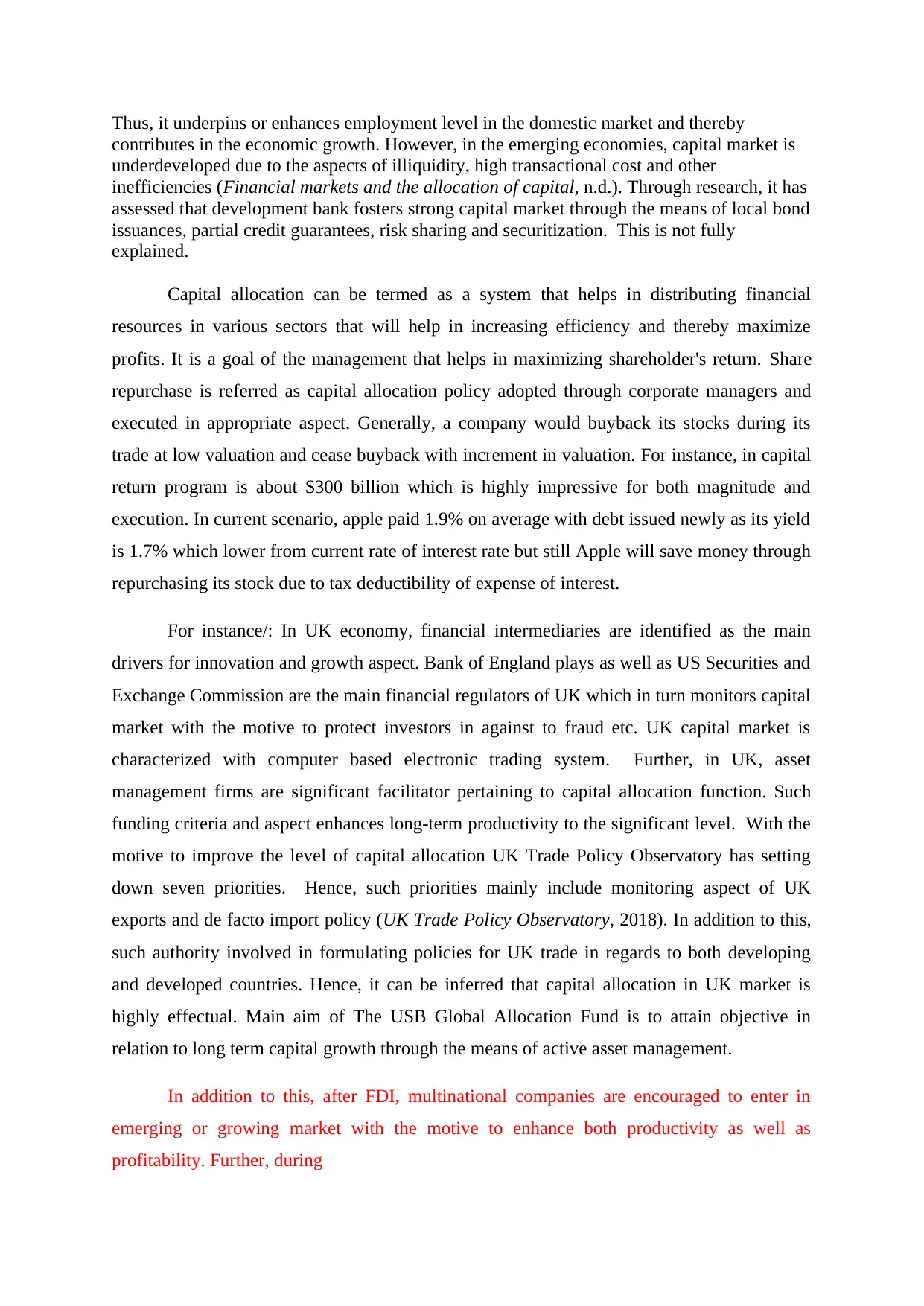
Thus, it underpins or enhances employment level in the domestic market and thereby
contributes in the economic growth. However, in the emerging economies, capital market is
underdeveloped due to the aspects of illiquidity, high transactional cost and other
inefficiencies (Financial markets and the allocation of capital, n.d.). Through research, it has
assessed that development bank fosters strong capital market through the means of local bond
issuances, partial credit guarantees, risk sharing and securitization. This is not fully
explained.
Capital allocation can be termed as a system that helps in distributing financial
resources in various sectors that will help in increasing efficiency and thereby maximize
profits. It is a goal of the management that helps in maximizing shareholder's return. Share
repurchase is referred as capital allocation policy adopted through corporate managers and
executed in appropriate aspect. Generally, a company would buyback its stocks during its
trade at low valuation and cease buyback with increment in valuation. For instance, in capital
return program is about $300 billion which is highly impressive for both magnitude and
execution. In current scenario, apple paid 1.9% on average with debt issued newly as its yield
is 1.7% which lower from current rate of interest rate but still Apple will save money through
repurchasing its stock due to tax deductibility of expense of interest.
For instance/: In UK economy, financial intermediaries are identified as the main
drivers for innovation and growth aspect. Bank of England plays as well as US Securities and
Exchange Commission are the main financial regulators of UK which in turn monitors capital
market with the motive to protect investors in against to fraud etc. UK capital market is
characterized with computer based electronic trading system. Further, in UK, asset
management firms are significant facilitator pertaining to capital allocation function. Such
funding criteria and aspect enhances long-term productivity to the significant level. With the
motive to improve the level of capital allocation UK Trade Policy Observatory has setting
down seven priorities. Hence, such priorities mainly include monitoring aspect of UK
exports and de facto import policy (UK Trade Policy Observatory, 2018). In addition to this,
such authority involved in formulating policies for UK trade in regards to both developing
and developed countries. Hence, it can be inferred that capital allocation in UK market is
highly effectual. Main aim of The USB Global Allocation Fund is to attain objective in
relation to long term capital growth through the means of active asset management.
In addition to this, after FDI, multinational companies are encouraged to enter in
emerging or growing market with the motive to enhance both productivity as well as
profitability. Further, during
contributes in the economic growth. However, in the emerging economies, capital market is
underdeveloped due to the aspects of illiquidity, high transactional cost and other
inefficiencies (Financial markets and the allocation of capital, n.d.). Through research, it has
assessed that development bank fosters strong capital market through the means of local bond
issuances, partial credit guarantees, risk sharing and securitization. This is not fully
explained.
Capital allocation can be termed as a system that helps in distributing financial
resources in various sectors that will help in increasing efficiency and thereby maximize
profits. It is a goal of the management that helps in maximizing shareholder's return. Share
repurchase is referred as capital allocation policy adopted through corporate managers and
executed in appropriate aspect. Generally, a company would buyback its stocks during its
trade at low valuation and cease buyback with increment in valuation. For instance, in capital
return program is about $300 billion which is highly impressive for both magnitude and
execution. In current scenario, apple paid 1.9% on average with debt issued newly as its yield
is 1.7% which lower from current rate of interest rate but still Apple will save money through
repurchasing its stock due to tax deductibility of expense of interest.
For instance/: In UK economy, financial intermediaries are identified as the main
drivers for innovation and growth aspect. Bank of England plays as well as US Securities and
Exchange Commission are the main financial regulators of UK which in turn monitors capital
market with the motive to protect investors in against to fraud etc. UK capital market is
characterized with computer based electronic trading system. Further, in UK, asset
management firms are significant facilitator pertaining to capital allocation function. Such
funding criteria and aspect enhances long-term productivity to the significant level. With the
motive to improve the level of capital allocation UK Trade Policy Observatory has setting
down seven priorities. Hence, such priorities mainly include monitoring aspect of UK
exports and de facto import policy (UK Trade Policy Observatory, 2018). In addition to this,
such authority involved in formulating policies for UK trade in regards to both developing
and developed countries. Hence, it can be inferred that capital allocation in UK market is
highly effectual. Main aim of The USB Global Allocation Fund is to attain objective in
relation to long term capital growth through the means of active asset management.
In addition to this, after FDI, multinational companies are encouraged to enter in
emerging or growing market with the motive to enhance both productivity as well as
profitability. Further, during
⊘ This is a preview!⊘
Do you want full access?
Subscribe today to unlock all pages.

Trusted by 1+ million students worldwide
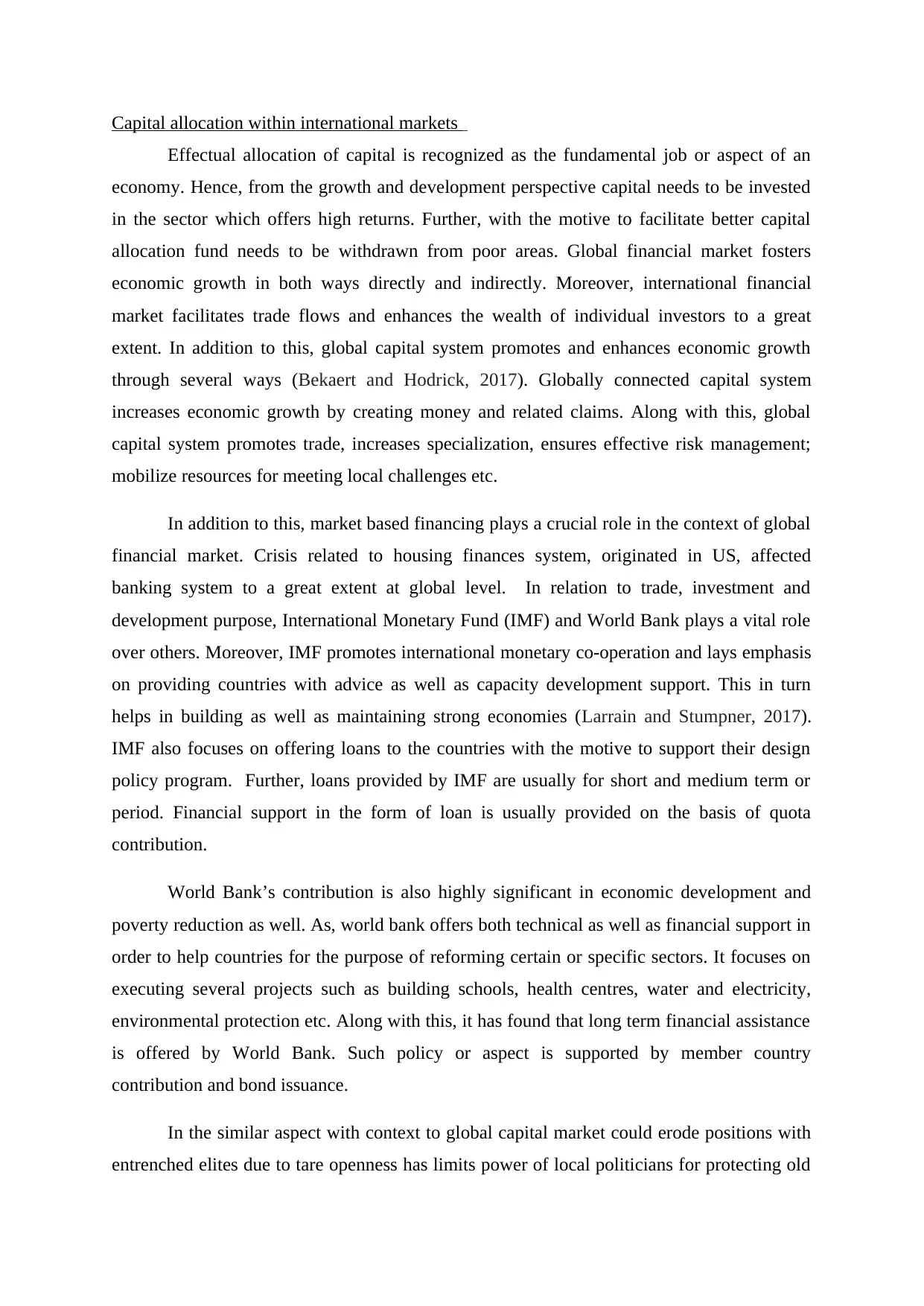
Capital allocation within international markets
Effectual allocation of capital is recognized as the fundamental job or aspect of an
economy. Hence, from the growth and development perspective capital needs to be invested
in the sector which offers high returns. Further, with the motive to facilitate better capital
allocation fund needs to be withdrawn from poor areas. Global financial market fosters
economic growth in both ways directly and indirectly. Moreover, international financial
market facilitates trade flows and enhances the wealth of individual investors to a great
extent. In addition to this, global capital system promotes and enhances economic growth
through several ways (Bekaert and Hodrick, 2017). Globally connected capital system
increases economic growth by creating money and related claims. Along with this, global
capital system promotes trade, increases specialization, ensures effective risk management;
mobilize resources for meeting local challenges etc.
In addition to this, market based financing plays a crucial role in the context of global
financial market. Crisis related to housing finances system, originated in US, affected
banking system to a great extent at global level. In relation to trade, investment and
development purpose, International Monetary Fund (IMF) and World Bank plays a vital role
over others. Moreover, IMF promotes international monetary co-operation and lays emphasis
on providing countries with advice as well as capacity development support. This in turn
helps in building as well as maintaining strong economies (Larrain and Stumpner, 2017).
IMF also focuses on offering loans to the countries with the motive to support their design
policy program. Further, loans provided by IMF are usually for short and medium term or
period. Financial support in the form of loan is usually provided on the basis of quota
contribution.
World Bank’s contribution is also highly significant in economic development and
poverty reduction as well. As, world bank offers both technical as well as financial support in
order to help countries for the purpose of reforming certain or specific sectors. It focuses on
executing several projects such as building schools, health centres, water and electricity,
environmental protection etc. Along with this, it has found that long term financial assistance
is offered by World Bank. Such policy or aspect is supported by member country
contribution and bond issuance.
In the similar aspect with context to global capital market could erode positions with
entrenched elites due to tare openness has limits power of local politicians for protecting old
Effectual allocation of capital is recognized as the fundamental job or aspect of an
economy. Hence, from the growth and development perspective capital needs to be invested
in the sector which offers high returns. Further, with the motive to facilitate better capital
allocation fund needs to be withdrawn from poor areas. Global financial market fosters
economic growth in both ways directly and indirectly. Moreover, international financial
market facilitates trade flows and enhances the wealth of individual investors to a great
extent. In addition to this, global capital system promotes and enhances economic growth
through several ways (Bekaert and Hodrick, 2017). Globally connected capital system
increases economic growth by creating money and related claims. Along with this, global
capital system promotes trade, increases specialization, ensures effective risk management;
mobilize resources for meeting local challenges etc.
In addition to this, market based financing plays a crucial role in the context of global
financial market. Crisis related to housing finances system, originated in US, affected
banking system to a great extent at global level. In relation to trade, investment and
development purpose, International Monetary Fund (IMF) and World Bank plays a vital role
over others. Moreover, IMF promotes international monetary co-operation and lays emphasis
on providing countries with advice as well as capacity development support. This in turn
helps in building as well as maintaining strong economies (Larrain and Stumpner, 2017).
IMF also focuses on offering loans to the countries with the motive to support their design
policy program. Further, loans provided by IMF are usually for short and medium term or
period. Financial support in the form of loan is usually provided on the basis of quota
contribution.
World Bank’s contribution is also highly significant in economic development and
poverty reduction as well. As, world bank offers both technical as well as financial support in
order to help countries for the purpose of reforming certain or specific sectors. It focuses on
executing several projects such as building schools, health centres, water and electricity,
environmental protection etc. Along with this, it has found that long term financial assistance
is offered by World Bank. Such policy or aspect is supported by member country
contribution and bond issuance.
In the similar aspect with context to global capital market could erode positions with
entrenched elites due to tare openness has limits power of local politicians for protecting old
Paraphrase This Document
Need a fresh take? Get an instant paraphrase of this document with our AI Paraphraser
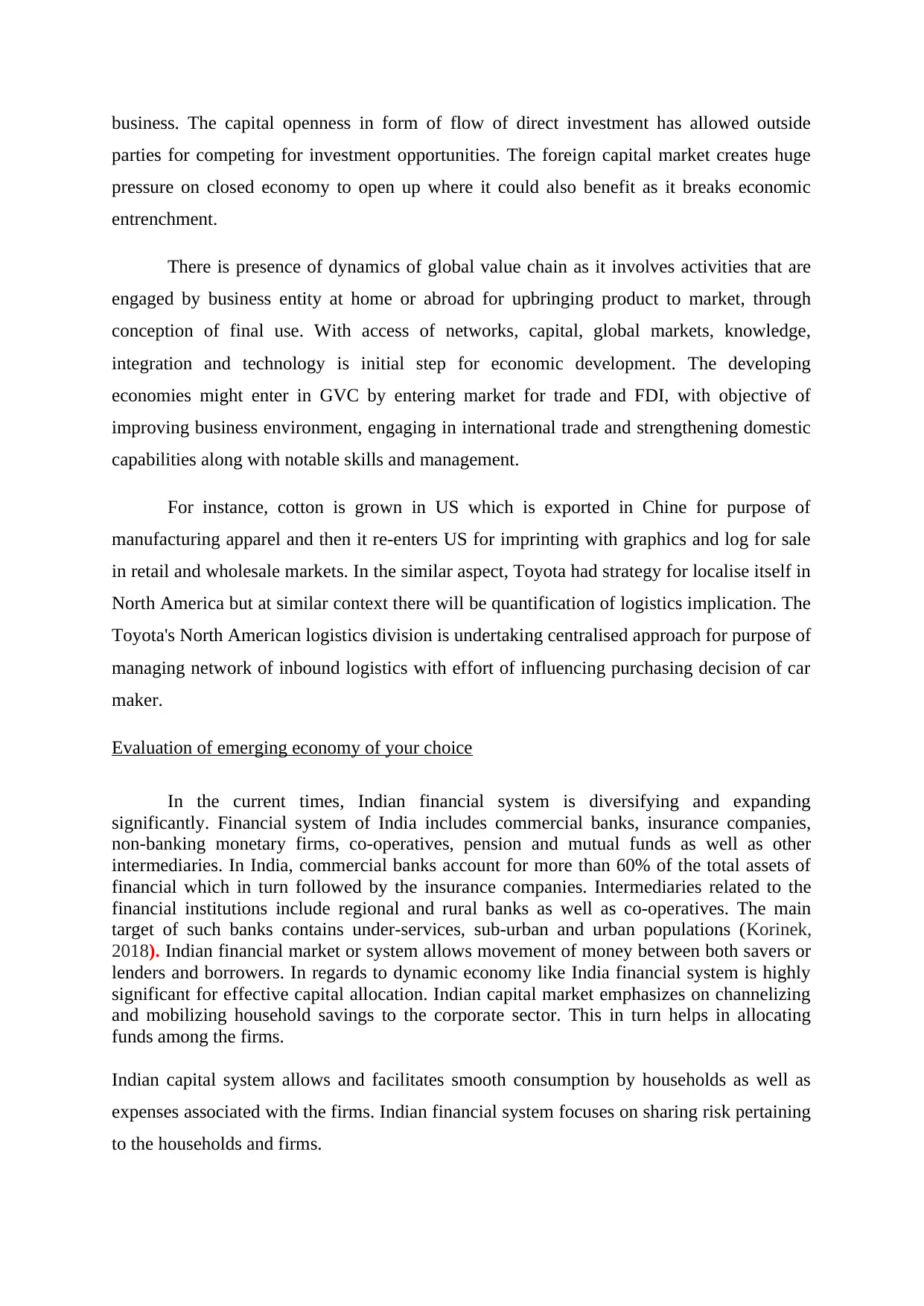
business. The capital openness in form of flow of direct investment has allowed outside
parties for competing for investment opportunities. The foreign capital market creates huge
pressure on closed economy to open up where it could also benefit as it breaks economic
entrenchment.
There is presence of dynamics of global value chain as it involves activities that are
engaged by business entity at home or abroad for upbringing product to market, through
conception of final use. With access of networks, capital, global markets, knowledge,
integration and technology is initial step for economic development. The developing
economies might enter in GVC by entering market for trade and FDI, with objective of
improving business environment, engaging in international trade and strengthening domestic
capabilities along with notable skills and management.
For instance, cotton is grown in US which is exported in Chine for purpose of
manufacturing apparel and then it re-enters US for imprinting with graphics and log for sale
in retail and wholesale markets. In the similar aspect, Toyota had strategy for localise itself in
North America but at similar context there will be quantification of logistics implication. The
Toyota's North American logistics division is undertaking centralised approach for purpose of
managing network of inbound logistics with effort of influencing purchasing decision of car
maker.
Evaluation of emerging economy of your choice
In the current times, Indian financial system is diversifying and expanding
significantly. Financial system of India includes commercial banks, insurance companies,
non-banking monetary firms, co-operatives, pension and mutual funds as well as other
intermediaries. In India, commercial banks account for more than 60% of the total assets of
financial which in turn followed by the insurance companies. Intermediaries related to the
financial institutions include regional and rural banks as well as co-operatives. The main
target of such banks contains under-services, sub-urban and urban populations (Korinek,
2018). Indian financial market or system allows movement of money between both savers or
lenders and borrowers. In regards to dynamic economy like India financial system is highly
significant for effective capital allocation. Indian capital market emphasizes on channelizing
and mobilizing household savings to the corporate sector. This in turn helps in allocating
funds among the firms.
Indian capital system allows and facilitates smooth consumption by households as well as
expenses associated with the firms. Indian financial system focuses on sharing risk pertaining
to the households and firms.
parties for competing for investment opportunities. The foreign capital market creates huge
pressure on closed economy to open up where it could also benefit as it breaks economic
entrenchment.
There is presence of dynamics of global value chain as it involves activities that are
engaged by business entity at home or abroad for upbringing product to market, through
conception of final use. With access of networks, capital, global markets, knowledge,
integration and technology is initial step for economic development. The developing
economies might enter in GVC by entering market for trade and FDI, with objective of
improving business environment, engaging in international trade and strengthening domestic
capabilities along with notable skills and management.
For instance, cotton is grown in US which is exported in Chine for purpose of
manufacturing apparel and then it re-enters US for imprinting with graphics and log for sale
in retail and wholesale markets. In the similar aspect, Toyota had strategy for localise itself in
North America but at similar context there will be quantification of logistics implication. The
Toyota's North American logistics division is undertaking centralised approach for purpose of
managing network of inbound logistics with effort of influencing purchasing decision of car
maker.
Evaluation of emerging economy of your choice
In the current times, Indian financial system is diversifying and expanding
significantly. Financial system of India includes commercial banks, insurance companies,
non-banking monetary firms, co-operatives, pension and mutual funds as well as other
intermediaries. In India, commercial banks account for more than 60% of the total assets of
financial which in turn followed by the insurance companies. Intermediaries related to the
financial institutions include regional and rural banks as well as co-operatives. The main
target of such banks contains under-services, sub-urban and urban populations (Korinek,
2018). Indian financial market or system allows movement of money between both savers or
lenders and borrowers. In regards to dynamic economy like India financial system is highly
significant for effective capital allocation. Indian capital market emphasizes on channelizing
and mobilizing household savings to the corporate sector. This in turn helps in allocating
funds among the firms.
Indian capital system allows and facilitates smooth consumption by households as well as
expenses associated with the firms. Indian financial system focuses on sharing risk pertaining
to the households and firms.
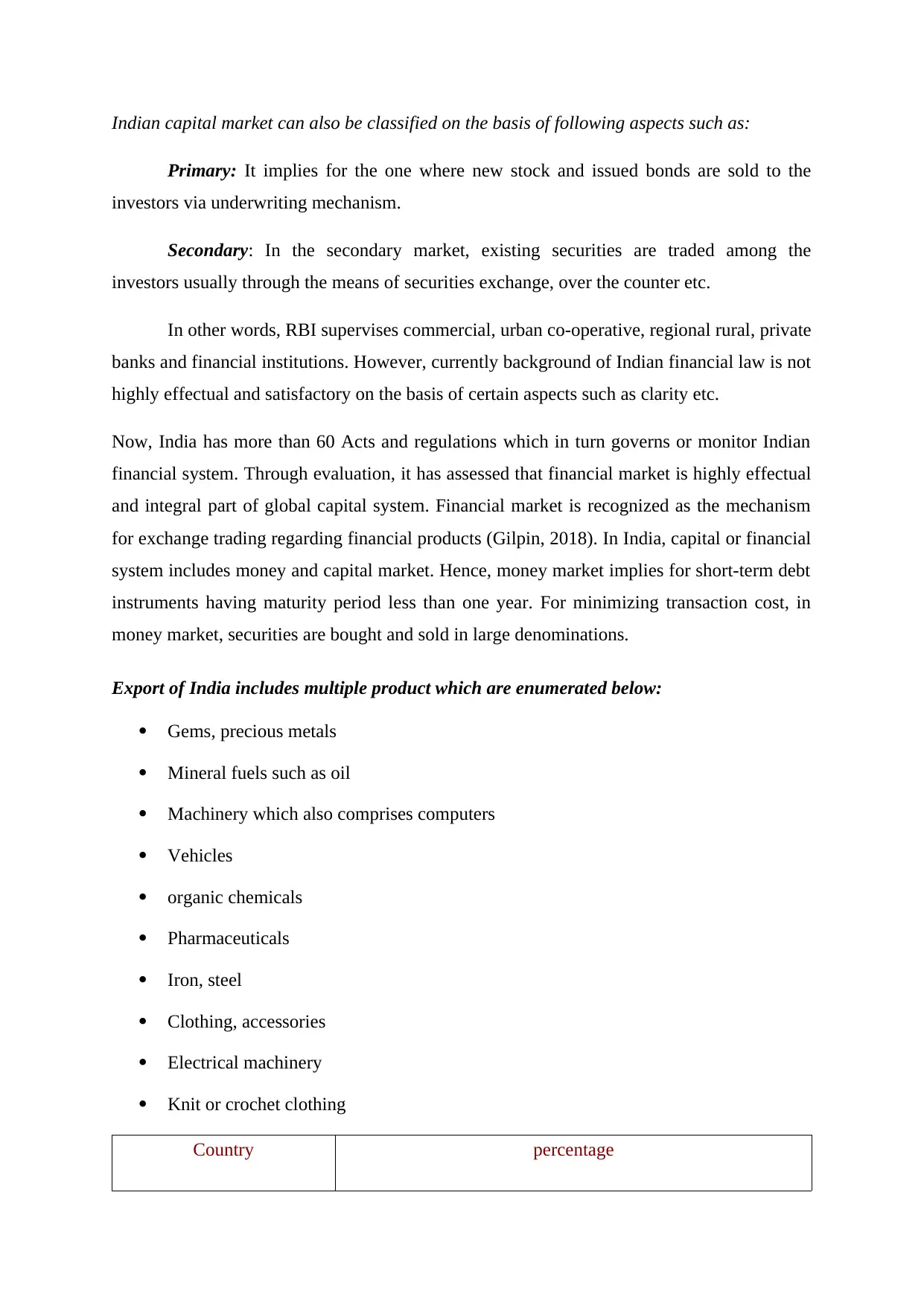
Indian capital market can also be classified on the basis of following aspects such as:
Primary: It implies for the one where new stock and issued bonds are sold to the
investors via underwriting mechanism.
Secondary: In the secondary market, existing securities are traded among the
investors usually through the means of securities exchange, over the counter etc.
In other words, RBI supervises commercial, urban co-operative, regional rural, private
banks and financial institutions. However, currently background of Indian financial law is not
highly effectual and satisfactory on the basis of certain aspects such as clarity etc.
Now, India has more than 60 Acts and regulations which in turn governs or monitor Indian
financial system. Through evaluation, it has assessed that financial market is highly effectual
and integral part of global capital system. Financial market is recognized as the mechanism
for exchange trading regarding financial products (Gilpin, 2018). In India, capital or financial
system includes money and capital market. Hence, money market implies for short-term debt
instruments having maturity period less than one year. For minimizing transaction cost, in
money market, securities are bought and sold in large denominations.
Export of India includes multiple product which are enumerated below:
Gems, precious metals
Mineral fuels such as oil
Machinery which also comprises computers
Vehicles
organic chemicals
Pharmaceuticals
Iron, steel
Clothing, accessories
Electrical machinery
Knit or crochet clothing
Country percentage
Primary: It implies for the one where new stock and issued bonds are sold to the
investors via underwriting mechanism.
Secondary: In the secondary market, existing securities are traded among the
investors usually through the means of securities exchange, over the counter etc.
In other words, RBI supervises commercial, urban co-operative, regional rural, private
banks and financial institutions. However, currently background of Indian financial law is not
highly effectual and satisfactory on the basis of certain aspects such as clarity etc.
Now, India has more than 60 Acts and regulations which in turn governs or monitor Indian
financial system. Through evaluation, it has assessed that financial market is highly effectual
and integral part of global capital system. Financial market is recognized as the mechanism
for exchange trading regarding financial products (Gilpin, 2018). In India, capital or financial
system includes money and capital market. Hence, money market implies for short-term debt
instruments having maturity period less than one year. For minimizing transaction cost, in
money market, securities are bought and sold in large denominations.
Export of India includes multiple product which are enumerated below:
Gems, precious metals
Mineral fuels such as oil
Machinery which also comprises computers
Vehicles
organic chemicals
Pharmaceuticals
Iron, steel
Clothing, accessories
Electrical machinery
Knit or crochet clothing
Country percentage
⊘ This is a preview!⊘
Do you want full access?
Subscribe today to unlock all pages.

Trusted by 1+ million students worldwide
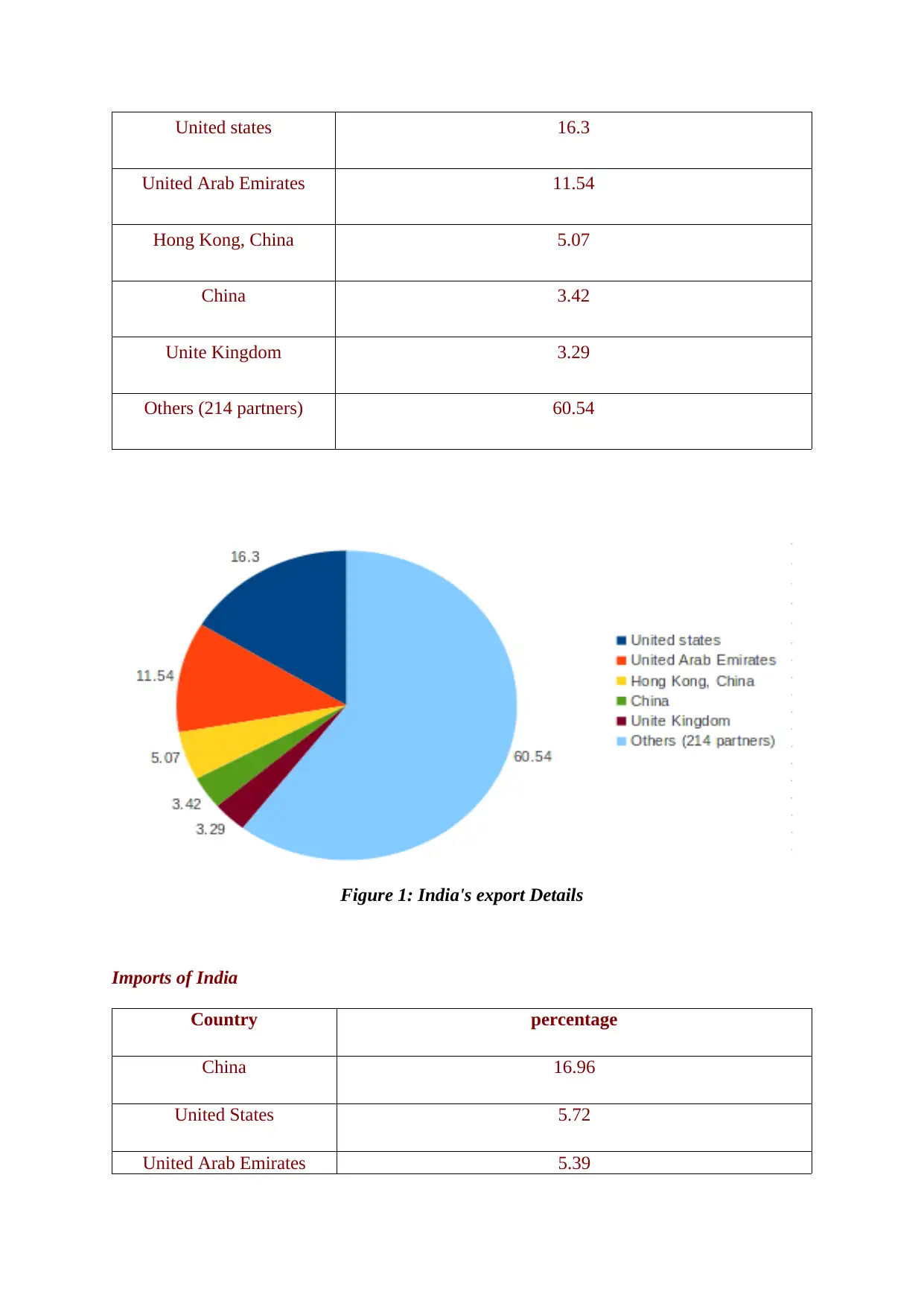
United states 16.3
United Arab Emirates 11.54
Hong Kong, China 5.07
China 3.42
Unite Kingdom 3.29
Others (214 partners) 60.54
Figure 1: India's export Details
Imports of India
Country percentage
China 16.96
United States 5.72
United Arab Emirates 5.39
United Arab Emirates 11.54
Hong Kong, China 5.07
China 3.42
Unite Kingdom 3.29
Others (214 partners) 60.54
Figure 1: India's export Details
Imports of India
Country percentage
China 16.96
United States 5.72
United Arab Emirates 5.39
Paraphrase This Document
Need a fresh take? Get an instant paraphrase of this document with our AI Paraphraser
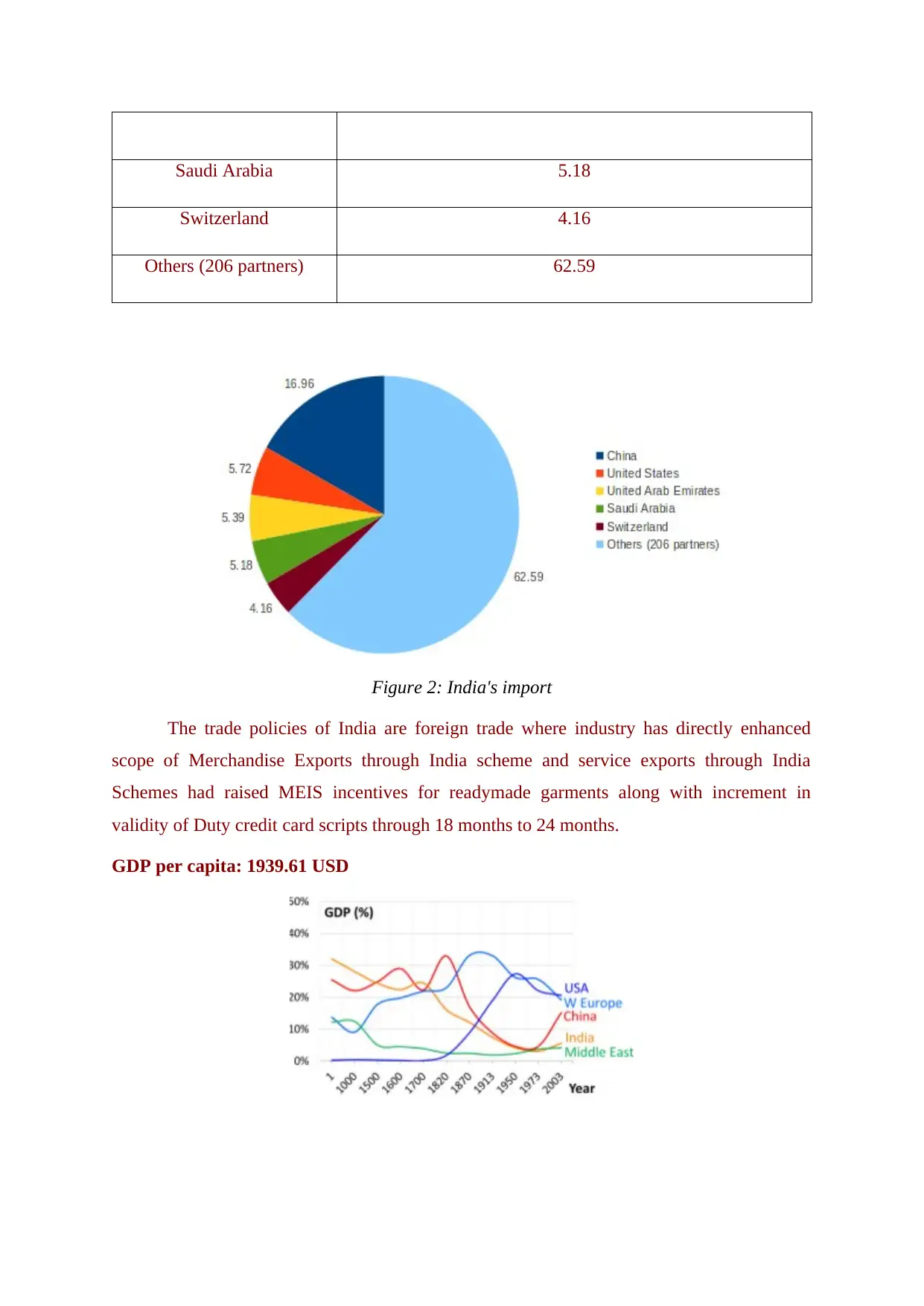
Saudi Arabia 5.18
Switzerland 4.16
Others (206 partners) 62.59
Figure 2: India's import
The trade policies of India are foreign trade where industry has directly enhanced
scope of Merchandise Exports through India scheme and service exports through India
Schemes had raised MEIS incentives for readymade garments along with increment in
validity of Duty credit card scripts through 18 months to 24 months.
GDP per capita: 1939.61 USD
Switzerland 4.16
Others (206 partners) 62.59
Figure 2: India's import
The trade policies of India are foreign trade where industry has directly enhanced
scope of Merchandise Exports through India scheme and service exports through India
Schemes had raised MEIS incentives for readymade garments along with increment in
validity of Duty credit card scripts through 18 months to 24 months.
GDP per capita: 1939.61 USD
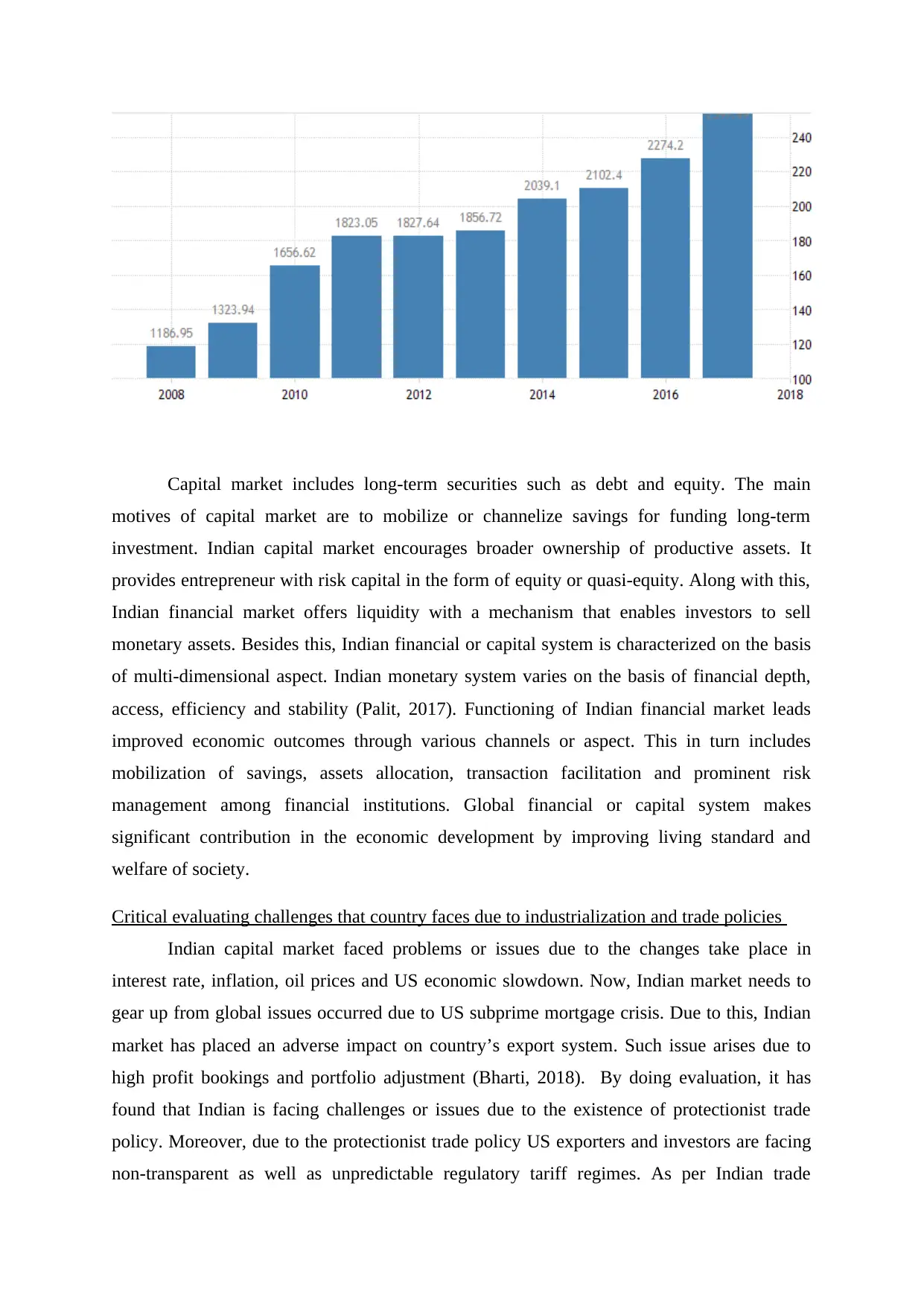
Capital market includes long-term securities such as debt and equity. The main
motives of capital market are to mobilize or channelize savings for funding long-term
investment. Indian capital market encourages broader ownership of productive assets. It
provides entrepreneur with risk capital in the form of equity or quasi-equity. Along with this,
Indian financial market offers liquidity with a mechanism that enables investors to sell
monetary assets. Besides this, Indian financial or capital system is characterized on the basis
of multi-dimensional aspect. Indian monetary system varies on the basis of financial depth,
access, efficiency and stability (Palit, 2017). Functioning of Indian financial market leads
improved economic outcomes through various channels or aspect. This in turn includes
mobilization of savings, assets allocation, transaction facilitation and prominent risk
management among financial institutions. Global financial or capital system makes
significant contribution in the economic development by improving living standard and
welfare of society.
Critical evaluating challenges that country faces due to industrialization and trade policies
Indian capital market faced problems or issues due to the changes take place in
interest rate, inflation, oil prices and US economic slowdown. Now, Indian market needs to
gear up from global issues occurred due to US subprime mortgage crisis. Due to this, Indian
market has placed an adverse impact on country’s export system. Such issue arises due to
high profit bookings and portfolio adjustment (Bharti, 2018). By doing evaluation, it has
found that Indian is facing challenges or issues due to the existence of protectionist trade
policy. Moreover, due to the protectionist trade policy US exporters and investors are facing
non-transparent as well as unpredictable regulatory tariff regimes. As per Indian trade
motives of capital market are to mobilize or channelize savings for funding long-term
investment. Indian capital market encourages broader ownership of productive assets. It
provides entrepreneur with risk capital in the form of equity or quasi-equity. Along with this,
Indian financial market offers liquidity with a mechanism that enables investors to sell
monetary assets. Besides this, Indian financial or capital system is characterized on the basis
of multi-dimensional aspect. Indian monetary system varies on the basis of financial depth,
access, efficiency and stability (Palit, 2017). Functioning of Indian financial market leads
improved economic outcomes through various channels or aspect. This in turn includes
mobilization of savings, assets allocation, transaction facilitation and prominent risk
management among financial institutions. Global financial or capital system makes
significant contribution in the economic development by improving living standard and
welfare of society.
Critical evaluating challenges that country faces due to industrialization and trade policies
Indian capital market faced problems or issues due to the changes take place in
interest rate, inflation, oil prices and US economic slowdown. Now, Indian market needs to
gear up from global issues occurred due to US subprime mortgage crisis. Due to this, Indian
market has placed an adverse impact on country’s export system. Such issue arises due to
high profit bookings and portfolio adjustment (Bharti, 2018). By doing evaluation, it has
found that Indian is facing challenges or issues due to the existence of protectionist trade
policy. Moreover, due to the protectionist trade policy US exporters and investors are facing
non-transparent as well as unpredictable regulatory tariff regimes. As per Indian trade
⊘ This is a preview!⊘
Do you want full access?
Subscribe today to unlock all pages.

Trusted by 1+ million students worldwide
1 out of 17
Related Documents
Your All-in-One AI-Powered Toolkit for Academic Success.
+13062052269
info@desklib.com
Available 24*7 on WhatsApp / Email
![[object Object]](/_next/static/media/star-bottom.7253800d.svg)
Unlock your academic potential
Copyright © 2020–2025 A2Z Services. All Rights Reserved. Developed and managed by ZUCOL.




